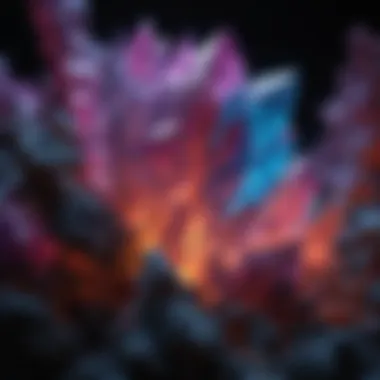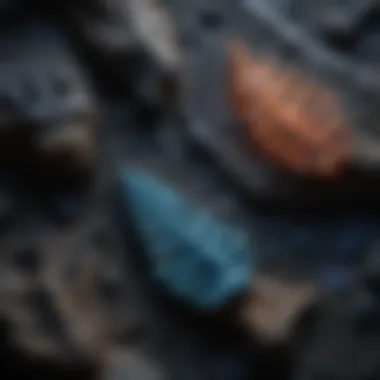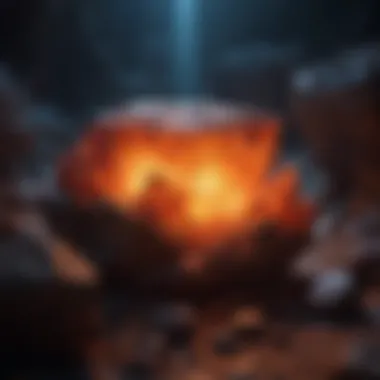Unveiling the Enigmatic Brilliance of Bright Blacklight in Geological Revelations


Rock and Fossil Identification
In the realm of geological exploration, the identification of rocks and fossils is a fundamental aspect that greatly benefits from the illumination of bright blacklight. Various types of rocks, ranging from sedimentary to igneous and metamorphic, each exhibit unique characteristics under this specialized light source. Fluorescing properties reveal hidden details such as mineral composition, age indicators, and even potential fossilization within rocks. As collectors and enthusiasts delve into the world of rock and fossil identification, the nuanced interplay between bright blacklight and geological specimens unveils a mesmerizing enigma.
Characteristics to look for: When using bright blacklight for rock and fossil identification, collectors should pay close attention to the fluorescence patterns exhibited. Certain minerals fluoresce in distinctive colors, aiding in the differentiation between rocks. In fossils, the fluorescence of organic materials like bone or shell fragments can be particularly striking under blacklight, helping to distinguish them from surrounding sedimentary matrix.
Tools for identification: Advanced tools like handheld UV lamps with different wavelength settings play a crucial role in effective rock and fossil identification. The accurate interpretation of fluorescing properties requires precision and expertise, making the use of specialized goggles to block extraneous light essential. In tandem with traditional identification methods, such as visual inspection and mineral testing, the integration of bright blacklight enhances the thorough examination and categorization of geological specimens.
Collecting Tips and Techniques
Geological enthusiasts immersed in the captivating world of rock and fossil collection can elevate their expeditions by incorporating bright blacklight into their arsenal of techniques. The synergy between this unique light source and collection practices enriches the overall experience, shedding light on hidden treasures and fossil mysteries.
Best practices for collecting: When embarking on collecting ventures, enthusiasts should prioritize thorough research to identify prime collecting sites and adhere to ethical collecting practices. The integration of bright blacklight enables collectors to spot hidden fluorescent minerals or fossils that might evade the naked eye in natural light conditions. Documenting findings with meticulous detail and accuracy enhances the scientific value of collected specimens.
Locating prime collecting sites: The process of scouting optimal collecting locations involves a blend of geological knowledge, historical exploration data, and informed decision-making. Bright blacklight serves as a valuable asset in locating sites rich in fluorescent minerals or fossils, amplifying the discovery potential and widening the scope of geological insights gained during expeditions.
How to safely extract specimens: Extracting delicate rock or fossil specimens requires precision and care to avoid damage or alteration of their inherent properties. Bright blacklight aids in the precise extraction of specimens by accentuating fluorescence patterns, guiding collectors in the meticulous separation of valuable samples from surrounding geological matrix.
Preservation and Display
As collectors amass a diverse array of rocks and fossils enriched by the nuances uncovered through bright blacklight exploration, the importance of proper preservation and creative display becomes integral to maintaining their scientific and aesthetic value.
Techniques for preserving rocks and fossils: Preservation techniques encompass a spectrum of methodologies, from stabilizing the physical integrity of delicate specimens to preventing mineral degradation over time. The identification of fluorescing minerals prone to deterioration under certain conditions enables collectors to tailor preservation methods effectively, ensuring the longevity of their geological treasures.
Proper storage methods: Implementing proper storage practices safeguards collected rocks and fossils from environmental hazards that could compromise their structural stability or visual appeal. Utilizing archival-quality materials, controlled humidity levels, and adequate labeling enhances the organization and preservation of specimens, enabling future generations to appreciate the geological wonders uncovered through bright blacklight exploration.
Creative display ideas: The art of displaying rocks and fossils reflects the creativity and passion of collectors, offering a unique platform to showcase the mesmerizing beauty of fluorescing specimens. Utilizing UV-reactive display cases, interactive lighting installations, or themed exhibitions enhances the visual impact and educational value of geological collections, captivating audiences and igniting curiosity about the hidden mysteries unveiled through the enigmatic allure of bright blacklight.
Geological Insights
Delving deeper into the realm of geological discoveries facilitated by bright blacklight, enthusiasts gain profound insights into the intricate formations, historical significance, and notable discoveries within the field of geology.
Geological formations and processes: The application of bright blacklight unveils the hidden intricacies of geological formations, illuminating mineral veins, strata patterns, and subtle structural details that hold clues to Earth's dynamic history. By deciphering fluorescence patterns and correlating them with geological processes, collectors and scientists can reconstruct the ancient landscapes and transformative forces that have shaped the Earth over millennia.


Historical significance of rocks and fossils: Bright blacklight not only serves as a tool for present-day exploration but also as a bridge to the past, unraveling the historical significance of rocks and fossils embedded with ancient narratives. From fossilized imprints of prehistoric creatures to minerals that bear witness to tectonic events, each fluorescing specimen tells a vivid tale of Earth's evolution, offering a window into geological epochs long gone.
Notable discoveries in the field: Throughout the annals of geological exploration, bright blacklight has played a pivotal role in uncovering groundbreaking discoveries that have reshaped our understanding of the natural world. From the identification of rare fluorescent minerals to the detection of hidden fossils in unassuming rock formations, these discoveries underscore the transformative impact of enhanced illumination in geological investigations, sparking new avenues of research and appreciation for Earth's geological wonders.
Introduction
In the realm of geological discoveries, the importance of bright blacklight is an intriguing subject that warrants exploration. This introductory section sets the stage for a deep dive into the mystique of bright blacklight and its significant role in unveiling hidden mysteries within geological specimens. By shedding light on how this unique light source illuminates fluorescing properties, an entirely new perspective on rock and fossil exploration emerges. The captivating interplay between light and minerals is not just educational but also enhances the experience of collectors and enthusiasts alike, making it a topic of high interest and relevance.
Understanding Bright Blacklight
Properties of Bright Blacklight
Bright blacklight stands out for its unique properties that play a crucial role in geological discoveries. Its ability to reveal fluorescing properties in minerals and rocks is unparalleled, making it a popular choice in diverse scientific and collecting environments. The key characteristic of bright blacklight lies in its capacity to trigger fluorescence in certain minerals, unveiling hidden hues and patterns that are invisible under normal light conditions. This distinctive feature of bright blacklight enhances the detection and identification of fluorescent minerals, offering a deeper insight into geological compositions. While bright blacklight provides valuable insights, its occasional limitations in accurately capturing all fluorescent responses in certain minerals should be considered within the context of this article.
Historical Significance
The historical significance of bright blacklight in geological explorations cannot be overstated. Throughout history, researchers and collectors have utilized blacklight as a tool to uncover hidden fluorescent properties in various minerals. Its legacy as a pioneering technology in mineral exploration and identification cements its place in the scientific community. The unique feature of historical significance lies in its enduring relevance and continuous adaptation in modern geological studies. While advocating for the benefits of historical significance in aiding geological discoveries, it is essential to acknowledge any limitations or misconceptions that may arise when interpreting historical data within the framework of this article.
Relevance in Geology
Identification of Minerals
One of the key aspects of bright blacklight's relevance in geology is its efficacy in mineral identification. By utilizing bright blacklight, geologists and collectors can differentiate minerals based on their fluorescence, leading to more accurate categorization and mapping of geological formations. The key characteristic of bright blacklight in identifying minerals lies in its ability to reveal distinct fluorescent signatures unique to each mineral type. This beneficial feature enhances the efficiency of mineral identification processes, showcasing its significance in the field of geology. Despite its advantages, the occasional challenge of accurately distinguishing certain minerals under bright blacklight conditions must be noted in the context of this article.
Detection of Fluorescent Characteristics
The detection of fluorescent characteristics through bright blacklight serves as a critical tool in geological investigations. By illuminating rocks and fossils with bright blacklight, scientists can identify specific fluorescing traits that provide valuable insights into their composition and origin. The key characteristic of this process lies in its ability to highlight fluorescent patterns that may go unnoticed under standard lighting conditions. The beneficial aspect of detection of fluorescent characteristics enhances the examination of geological samples, offering a deeper understanding of their underlying properties. However, it is imperative to recognize any discrepancies or challenges that may arise when interpreting fluorescent responses under varying light sources within the purview of this article.
Exploration of Fluorescent Minerals
In the fascinating realm of geological discoveries, the exploration of fluorescent minerals stands as a pivotal aspect, shedding light on hidden wonders within rocks and fossils. This exploration delves deep into the unique qualities of fluorescing properties when exposed to bright blacklight, unraveling a world of vibrant colors and unseen traits. By focusing on the specific elements of fluorescence in minerals, geologists and collectors can gain valuable insights into the composition and characteristics of these specimens. Understanding the benefits of exploring fluorescent minerals opens up new avenues for geological analysis, providing a fresh perspective on rock formations and fossil structures. Considerations about this exploration include the meticulous observation of fluorescence patterns, the correlation between minerals and their fluorescence, and the implications for geological research and identification.
Fluorescence Phenomenon
Scientific Explanation:


The scientific explanation behind fluorescence phenomenon is a cornerstone of this article, offering a deeper understanding of how minerals interact with light. By delving into the specific aspects of scientific explanations related to fluorescence, readers can grasp the complex yet fascinating processes that govern this phenomenon. Highlighting the key characteristic of scientific explanation in this context underscores its significance in unraveling the mysteries of fluorescing minerals. The unique feature of scientific explanation lies in its ability to provide a systematic framework for interpreting fluorescence in geological specimens, offering valuable insights for researchers and enthusiasts alike. While it comes with certain limitations, its benefits far outweigh any drawbacks in shedding light on the intricate world of fluorescent minerals.
Variability in Fluorescent Responses:
The variability in fluorescent responses adds another layer of importance to the exploration of these minerals, showcasing the diverse range of interactions between minerals and blacklight. Understanding the intricacies of how minerals exhibit fluorescence differently enhances the overall appreciation for their unique qualities. Highlighting the key characteristic of variability in fluorescent responses emphasizes the dynamic nature of mineral fluorescence, where no two specimens react in exactly the same way under blacklight. This variability allows for a more nuanced approach to mineral identification and analysis, contributing to a richer geological exploration experience. While this variability may pose challenges in consistency, it enriches the exploration process by providing a mosaic of responses that deepen our understanding of mineral fluorescence within geological contexts.
Impact on Collection
Enhanced Display Aesthetics:
A key aspect of exploring fluorescent minerals is the enhanced display aesthetics they introduce to collections. The vibrant hues and captivating glow emitted by fluorescing minerals under blacklight elevate the visual appeal of any geological display. By emphasizing the key characteristic of enhanced display aesthetics, collectors and enthusiasts can appreciate the beauty and allure of these minerals in a new light. The unique feature of enhanced display aesthetics lies in its ability to transform ordinary mineral specimens into mesmerizing works of natural art, captivating audiences and sparking curiosity. While there may be considerations regarding the preservation of fluorescence over time, the aesthetic enhancement it brings to collections is unparalleled.
Value in Collecting:
The value of collecting fluorescent minerals extends beyond aesthetics, delving into the scientific and intrinsic worth of these specimens. By understanding the value in collecting fluorescent minerals, enthusiasts can appreciate the unique properties and rare characteristics that make these specimens highly sought after. Highlighting the key characteristic of value in collecting underscores the significance of these minerals as valuable additions to geological collections. The unique feature of value in collecting lies in the blend of scientific intrigue, visual appeal, and geological rarity that each fluorescent specimen possesses. While there may be considerations regarding the authenticity and provenance of collected minerals, the value they bring to collections and the geological community is immeasurable.
Practical Applications in Rock and Fossil Examination
Exploring the practical applications in rock and fossil examination delves into the intricate methods and tools used to unravel the mysteries concealed within geological specimens. It is imperative to comprehend the significance of these applications in shedding light on the composition, structure, and historical context of various minerals and fossils. Through detailed examinations and analyses, researchers can decipher vital information about the Earth's geological past and present evolution.
Identification Techniques
Differentiating Minerals
When elucidating the process of differentiating minerals, it is essential to grasp the unique properties and characteristics that set each mineral apart. By honing in on specific attributes such as color, luster, hardness, and crystal structure, geologists can discern one mineral from another with precision and accuracy. This meticulous distinction aids in the comprehensive examination of geological specimens, contributing to a deeper understanding of the Earth's composition and mineral diversity. The ability to differentiate minerals plays a pivotal role in identifying specific mineral species, enabling researchers to draw valuable insights and conclusions from their studies.
Mapping Geological Features
Mapping geological features involves the systematic recording and visualization of various geological elements present in a specific area. Through detailed mapping techniques such as stratigraphic mapping, structural mapping, and lithological mapping, geologists can create comprehensive geological maps that highlight key terrain characteristics and formations. These maps serve as crucial tools in understanding geological processes, identifying potential mineral deposits, and predicting geological hazards. By mapping geological features, researchers can navigate through complex geological landscapes and unveil hidden insights about the Earth's geological history and evolution.
Research Advancements
Contributions to Geoscience


Examining the contributions of practical applications in rock and fossil examination to geoscience underscores the immense value and significance of these tools and techniques in broadening our understanding of the Earth's geological dynamics. By integrating advanced technologies such as spectroscopy, X-ray diffraction, and electron microscopy, researchers can delve deeper into the composition and structure of minerals and fossils, opening doors to new avenues of scientific inquiry and discovery. These contributions empower geoscientists to conduct cutting-edge research, enhance geological exploration, and make groundbreaking contributions to the field of geoscience.
Innovative Discoveries
The realm of innovative discoveries within practical applications in rock and fossil examination unveils the transformative impact of technology and research in revolutionizing our understanding of the Earth's geological composition. Through innovative techniques such as 3D imaging, geochemical analysis, and remote sensing, researchers can unearth unprecedented insights into geological processes, mineral formations, and fossil deposition. These discoveries fuel groundbreaking advancements in geoscience, fostering interdisciplinary collaborations and pushing the boundaries of geological exploration and discovery.
Technological Enhancements in Bright Blacklight Tools
In the realm of geological discoveries, the advancements in bright blacklight tools play a pivotal role in enhancing the exploration process. These technological enhancements bring to light the hidden mysteries within geological specimens with unparalleled clarity and precision. By harnessing the power of UV light sources, researchers and enthusiasts can delve deeper into the fluorescing properties of minerals, opening up new dimensions of understanding and exploration that were previously inaccessible. The significance of technological advancements in bright blacklight tools lies in their ability to revolutionize how we perceive and interact with geological samples, offering unique insights and revelations that traditional examination methods cannot achieve. The integration of cutting-edge technology in blacklight tools elevates the entire experience of geological exploration, providing a more detailed and nuanced view of the mineral compositions and fluorescent characteristics present in various rocks and fossils.
UV Light Sources
Development Trends: Exploring the development trends in UV light sources sheds light on the evolution of this essential tool in geological investigations. These trends encompass innovations such as enhanced UV emission spectra, longer lifespan of bulbs, and improved portability, all of which contribute to a more efficient and effective exploration process. The key characteristic of these development trends is their focus on optimizing the spectral output of UV light sources to maximize the detection of fluorescent minerals and features. This focus on spectral refinement results in a more accurate and detailed representation of geological specimens under blacklight, enhancing the overall quality of observations and analyses conducted in this field. The unique feature of these development trends lies in their ability to cater specifically to the requirements of geological investigations, providing researchers with the tools needed to uncover hidden details and anomalies within rocks and fossils.
Efficiency Improvements: Efficiency improvements in UV light sources address the need for increased reliability and performance in geological examinations. These improvements encompass factors such as energy efficiency, durability, and reduced heat emissions, ensuring a more sustainable and user-friendly operation of blacklight tools. The key characteristic of efficiency improvements is their capacity to deliver consistent and dependable UV illumination, allowing for prolonged study sessions without compromising the quality of observations. The unique feature of these efficiency improvements lies in their ability to enhance the overall experience of using blacklight tools, making them more accessible and convenient for researchers and collectors alike while minimizing potential drawbacks such as overheating or bulb malfunctions.
Portable Devices
Accessibility for Fieldwork: Portable devices play a crucial role in facilitating fieldwork activities related to geological exploration by providing researchers with the flexibility and mobility needed to conduct on-site analyses. The key characteristic of accessibility for fieldwork lies in the portability and practicality of these devices, allowing for quick and efficient examination of geological samples in diverse locations. This feature enables researchers to gather real-time data and observe fluorescing properties of minerals on-site, streamlining the data collection process and enhancing the overall efficiency of fieldwork operations. The unique feature of accessibility for fieldwork is its ability to bridge the gap between traditional laboratory settings and outdoor environments, empowering researchers to make accurate observations and valuable discoveries in challenging terrains and conditions.
Enhanced Portability: The enhanced portability of modern blacklight devices revolutionizes the way geological enthusiasts engage with their collections and studies. This feature focuses on compact design, lightweight construction, and user-friendly interfaces that make blacklight tools accessible to a wider range of users. The key characteristic of enhanced portability is its seamless integration into various settings and contexts, allowing collectors to examine their specimens with ease and convenience. The unique feature of enhanced portability lies in its capacity to enrich the overall collecting experience, enabling enthusiasts to appreciate the fluorescent properties of minerals in a more interactive and immersive manner. By offering enhanced portability, blacklight devices become indispensable companions for those seeking to unravel the mysteries hidden within geological treasures.
Artistic Interpretations and Aesthetic Appreciation
Visual Spectacle
Photographic Opportunities
Photographic opportunities represent a crucial aspect of capturing the essence and intricacies of fluorescing minerals when exposed to bright blacklight. With the right photographic techniques, enthusiasts can immortalize the vivid hues and mesmerizing glow emitted by these minerals, creating striking visuals that serve as a documentation of geological wonders. The key characteristic of photographic opportunities lies in their ability to freeze a moment in time, preserving the enchanting fluorescence for further examination and admiration. Despite the challenges posed by capturing fluorescence through photography, the rewards are immense, offering a visually stimulating account of the inherent beauty found within geological specimens.
Stimulating Creativity
Stimulating creativity in the realm of bright blacklight and geological discoveries fosters a profound connection between the observer and the natural world. By encouraging artistic expression and interpretation, this aspect of the topic invites individuals to explore their imaginative faculties and engage with minerals and rocks in a creative manner. The key characteristic of stimulating creativity is its transformative influence on how we perceive geological specimens, inviting us to look beyond their scientific value and delve into the realm of aesthetic appreciation. While stimulating creativity can introduce subjective interpretations and perspectives, it provides a platform for unique expressions of admiration and creativity within the context of geological exploration.
Cultural Significance
Cultural significance transcends the scientific realm of bright blacklight in geological discoveries, infusing historical context and societal value into the exploration of minerals and rocks. Artistic representations serve as tangible embodiments of culture and traditions, reflecting human interaction with geological specimens throughout history. By portraying minerals in various art forms, from paintings to sculptures, artistic representations bridge the gap between scientific exploration and cultural appreciation, offering a holistic view of geological significance within different civilizations.
Historical Reflections
Historical reflections shed light on the legacy and impact of geological discoveries on human history, emphasizing the enduring fascination with minerals and rocks over centuries. By delving into the historical context of geological exploration, this aspect of the topic highlights key moments and discoveries that have shaped our understanding of the Earth's composition and geological processes. The key characteristic of historical reflections lies in their ability to connect past achievements with present-day advancements, offering insights into the evolution of geological sciences and the continued relevance of bright blacklight in uncovering hidden treasures within the Earth's crust.







